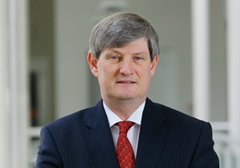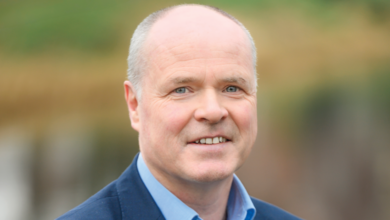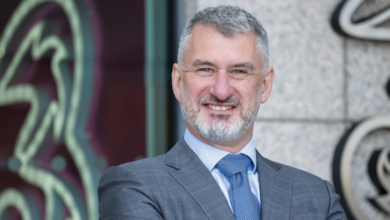ESB’s Pat O’Doherty on expansion plans
 ESB Chief Executive Pat O’Doherty talks about the challenges and opportunities facing the energy sector and shares his company’s ambitions to expand into Britain with Owen McQuade.
ESB Chief Executive Pat O’Doherty talks about the challenges and opportunities facing the energy sector and shares his company’s ambitions to expand into Britain with Owen McQuade.
A turbulent time for energy is bringing uncertainty and challenges but also presents exciting possibilities, recently appointed ESB Chief Executive Pat O’Doherty remarks as he takes stock of the sector’s current landscape.
The challenges facing ESB, in his view, fall into two categories: operational and strategic. Operationally, the company faces “huge uncertainty” in many of its markets. The future of commodity fuels and related technologies is uncertain, as are the regulatory, market and policy environments. “Planning a business against the background of such uncertainty is a huge challenge. We’ve come off the back of 10 years of extraordinary investment in the company, reflecting the economic growth of that period. Now we need to adapt to a much different environment and the consequent downturn in demand while at the same time positioning for future investment growth in sustainable energy technologies and systems”.
O’Doherty is leading a major cost reduction programme which aims to take €280 million of costs per annum out of the business, of which €140 million is payroll; the company has reached a “ground-breaking” agreement with ESB’s trade unions to achieve the latter. “But ultimately we operate in a very competitive environment,” he says. “And we have to ensure the competitiveness of our business.” Essentially, this means ensuring that the generation and supply businesses can compete successfully in changing energy markets, and that Ireland’s network infrastructure is appropriate i.e. affordable, performing well and providing good customer service.
The economic crisis cannot be avoided. “Access to funding at the right cost” is critical for ESB in the current economic environment. As a long-cycle, capital-intensive business, ESB has an extensive capital investment programme and has to borrow on the international debt markets.
Taking the long view in this uncertain context presents another set of challenges for ESB and it’s critical to make the right strategic choices. The energy industry is facing unprecedented technological change and remaining relevant as “a scale player” in the emerging regional electricity markets (Ireland-Great Britain and then with France and the rest of Europe) is a major strategic objective.
“The British market is ten times the size of Ireland’s Single Electricity Market (SEM) and, in generation and supply terms, ESB accounts for less than half the market in Ireland,” he notes. That said, O’Doherty believes that the Single Market has been a huge success.
“In 2002, ESB was a monopoly in Generation and Supply in the Republic of Ireland. Since then, we’ve moved through regulation of market entry in generation, to the phased opening of supply markets starting with I&C [industrial and commercial] customers, the introduction of the all-Island wholesale Single Electricity Market in 2007 and full competition in the residential market in 2009.”
O’Doherty says: “The market here has been very successful from a competition point of view and Irish prices for virtually all categories of electricity customers are at or below the European average. This is despite the structural disadvantages Ireland faces, such as the smaller scale power plants (typically half the size of GB plants), high dependence on fossil fuels and a networks system that has four times more network per customer than the European average because of the dispersed population density.”
ESB, through Electric Ireland, now has complete freedom in end-user pricing. O’Doherty is clearly relaxed about being one of many players in an all-island market and the prospect of competing in an ‘all-islands market’. “Each of the big six in Britain is similar in size to the whole Single Electricity Market,” he explains for context.
Competing as a strong organisation in a large integrated market is central to his overall vision for the company. “My strategic direction for ESB is to be a vertically integrated player of scale, competing successfully in a regional electricity market and providing the underpinning networks infrastructure in Ireland on an all-island basis.”
Developing a presence in Britain is a “key strategic imperative”, both as an “offensive” and “defensive” tactic. O’Doherty explains that ESB is not permitted to develop more generation capacity in Ireland “until such time as ESB’s market share is deemed to be acceptable” but the Irish market still needs an indigenous scale player. That goes in tandem with growing the British share of the market.
“With interconnection between the two islands, our home market now is Ireland and Great Britain,” he states, “so developing investment in merchant capability in Great Britain is important for ESB if we are to remain a generation player of scale in a regional market.”
O’Doherty notes that Ireland is on target to meet the Government’s 40 per cent renewable electricity target by 2020. ESB sees its role as providing the right network infrastructure to support that policy.
“I believe the future is electric. The decarbonisation of electricity through sustainable power generation and the adoption of electricity as the fuel of choice will together deliver sustainable energy for Ireland in the wider sense.”
New technologies such as electric vehicles and smart networks are necessary to produce a sustainable outcome, but energy efficiency also has an important role to play. ESB’s retail business, Electric Ireland, is moving beyond the traditional provision of electricity (and now gas) towards energy efficiency, energy products and energy services. The company already has a long track record in this field, particularly in ensuring efficient energy systems for larger commercial and industrial customers. Moving “beyond the meter” services into the domestic sector as an Energy Services Company (ESCo) is “very exciting” for the energy utility, and will require a strong customer focus and brand capability.
“With the completion of the East-West interconnector later this year, close to
20 per cent of Ireland’s maximum demand can be met through interconnection,” he comments, before making an obvious but overlooked point. “That’s assuming, of course, that there’s the generation capability on the other side of the interconnection to make that work. Interconnection, of itself, doesn’t guarantee security of supply.” Market arrangements and interconnection must work together to deliver a secure supply of electricity.
Renewables, he emphasises, cannot solve the energy security problem alone and fossil fuel generation (combined cycle gas turbines) is essential to boost supply when the wind isn’t blowing. The Moneypoint coal-fired power station in County Clare will reach the end of its working life in the mid-2020s.
Distributed generation, electric vehicles (whose batteries provide a storage facility for excess wind generation) and indigenous gas from the Corrib basin will certainly be part of the energy landscape going forward, he asserts.
In this edition, UK Government advisor David Newbery (see pages 56-57) describes how the SEM’s pool system is leading the way for Great Britain. “What’s going on in GB is very interesting,” O’Doherty says. “We’ve had three or four evolutions of that market since its inception, and each of them has been designed to fix a problem that emerged.”
The British market, he contends, gives no incentive to build long-term assets, such as coal or nuclear plant, which take 20 to 30 years to make a return on the investment. It does incentivise combined cycle gas plant, which is relatively easy to build and has a faster payback over eight to 15 years. Wind and other renewables have been incentivised, but only by subsidy.
GB electricity market reform in that context is “struggling with lots of constructs to solve the long-term security of supply problem” and nuclear, which was a critical element of UK Government energy policy “looks like it’s been set back yet again.” The market started off with a capacity mechanism, which was then abandoned and is now being reconsidered under the current reform proposals.
“The SEM addresses many of those challenges and is probably the most economically pure market in Europe,” he adds, “and yet the EU target model that’s been set for market integration doesn’t mirror the SEM.”
O’Doherty points to ESRI studies which have concluded that pricing in the SEM is economic whereas that in Britain is not, and that wholesale electricity prices would have to increase in Britain to more long run economic levels.
International
ESB is “very proud” of ESB International, its engineering consultancy business. It started 35 years ago in Bahrain (where it has been operating consistently since) and has worked in over 100 countries since then. It’s alignment with an operating utility is, to him, its greatest advantage.
“We’re one of the few international engineering consultancy businesses that are part of a fully integrated operational utility value chain,” he notes. “We can develop our people through our core business and into our international businesses, and vice versa. That’s something that gives us a competitive advantage with our clients.”
Importantly, he notes that ESB International allows ESB to maintain an in-house engineering capability which otherwise would not be possible, with the resulting skills and experience being provided both to ESB and to client companies. ESB International currently operates in 20 countries. Projects include a rural electrification project in Tanzania, a submarine transmission cable between Zanzibar and mainland Tanzania, a new CCGT power plant in Namibia, root cause analysis for power plant failures in Oman, and power plant operations and maintenance in Pakistan and Malaysia.
His target is to double the scale of ESB International’s external business over the next four years across all of its operations.
Through ESB International, ESB also identifies new areas of opportunity. Carbon solutions which helps developing countries meet their commitments to reduce emissions is one example. He explains: “We invest in carbon and methane reduction projects in developing countries under the CDM [the Kyoto Protocol’s Clean Development Mechanism]. By investing in these projects, we can access carbon credits under the CDM at a low cost, which we can either trade or use to cover our exposure in our core generating businesses.”
Reflections
Looking back on the industry over the recession years, O’Doherty reflects: “I don’t think anybody could have anticipated the kind of economic environment we find ourselves in.” Back in 2006, forecasts were for 2-4 per cent growth in generation but the island now has at least 2GW of surplus generating capacity: “That’s the script that nobody would have written.”
On the technical side, CCGT technology has transformed the business, partly by shortening the lead time for construction. “ESB was the first in the world to embrace CCGT technology by repowering the old North Wall oil-fired station in Dublin in a collaboration with GE back in the early ‘80s,” he recalls. “We’re now recognised as having a major CCGT capability, and this is an underpinning competence for our international activities.”
This advantage led to ESB being involved with one of the first CCGT based independent power producer developments in Britain in the early 1990’s. The 350MW CCGT at Corby, near Northampton, started as a joint venture with E.On and ESB bought out the German utility’s share last year.
Tolling was ESB’s original model for investment in Britain, whereby it took risk on designing, building and operating a CCGT plant but avoided the market risks associated with energy trading by contracting the power under a tolling agreement. “With the upcoming integration of the two markets, we’re moving beyond that into the development of merchant plants.”
Ultimately the greatest strategic challenge is deciding “what horses a utility like ESB should back” among the wide range of technological choices, particularly when the environment remains so uncertain and some of those technologies have long payback times.
“So it’s picking the right technologies,” he adds, “to make sure that our mix of technology, particularly our generation mix, is not out of market and that our cost of production is competitive.” It’s a matter of plotting through “this fog of technological, policy, regulatory and market uncertainty” but he also finds it exciting.
“Our industry is over 100 years old and the traditional model of the industry, large, centralised generation with meshed transmission and radial distribution feeding customer load, has remained unchanged, by and large, over that period,” he states.
The emerging energy system is both centralised and distributed, with power potentially flowing in any direction at any time from sources ranging from distributed micro generation, to wind farms and large thermal plants. The convergence of ICT and energy technologies also promises to create a “much more dynamic, flexible, real-time and responsive” process from production all the way through to the consumer.
ESB’s new Chief Executive Pat O’Doherty speaking at Energy Ireland 2012






